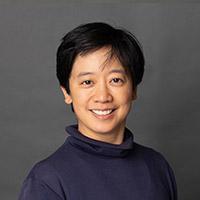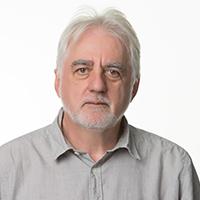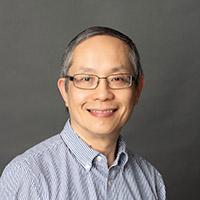Geometry & Topology
Geometry deals with quantitative properties of space, such as distance and curvature on manifolds. Topology deals with more qualitative properties of space, namely those that remain unchanged under bending and stretching. (For this reason, topology is often called “the geometry of rubber sheets”.) The two subjects are closely related and play a central role in many other fields such as Algebraic Geometry, Dynamical Systems, and Physics. At McMaster research focuses on Algebraic Topology (homotopy theory, K-theory, surgery), Geometric Topology (group actions on manifolds, gauge theory, knot theory), and Differential Geometry (curvature, Dirac operators, Einstein equations, and general relativity).
Information Box Group
Hans U. Boden
Professor
Research Area: geometry-topology
Research Profile: Gauge theory and low-dimensional topology.
My research concerns the topology and geometry of character varieties and moduli spaces of flat connections, and applications to invariants of knots, links, and 3-manifolds.
Ian Hambleton
Dr. F. Ronald and Helen E. Britton Professor of Mathematics
Research Area: geometry-topology
Research Profile: Algebraic and geometric topology
One of the unifying principles in geometry is that complex systems, such as configurations of planets and stars can often be understood by means of their symmetries. Familiar symmetries include the rotations or reflections of solids in space and the Lorentz transformations of space- time. Discrete invariants and groups of symmetry of continuous motions are studied in algebraic topology, while geometric topology is concerned with the properties of differential manifolds, or higher-dimensional surfaces. Topology developed rapidly in the period between 1950 and 1980 and is now one of the most active fields of mathematics. Symmetries of differentiable manifolds are related to algebra and number theory through group theory, and to partial differential equations and analysis through differential forms. My recent work deals with finite group actions on 4-dimensional manifolds and their connections to gauge theory, and infinite discrete group actions on high-dimensional manifolds. Both areas provide many opportunities for interesting research problems.

Ian Hambleton
Dr. F. Ronald and Helen E. Britton Professor of Mathematics
Megumi Harada
Professor and Canada Research Chair
Research Area: geometry-topology
Research Profile: Geometry and Topology
More specifically, I compute topological invariants, such as equivariant cohomology theories, of spaces with such structure. Symplectic geometry is the mathematical framework of classical physics; hyperkahler manifolds are symplectic manifolds wiht extra structure, are of particular recent interest due to their connections to theoretical physics. I am mainly concerned with the theory of symmetries of manifolds with these structures, as encoded by a Hamiltonian Lie group action, i.e. there exists a moment map on M encoding the action by Hamiltonian flows. Such group actions on symplectic and hyperkahler manifolds arise naturally in the context of physics, representation theory, and algebraic geometry. To a Hamiltonian space, one associates a symplectic (hyperkahler) quotient, which inherits a symplectic (hyperkahler) structure from the original manifold. The main theme of my recent research is the study of the topology and equivariant topology of these quotients, in particular the computation of their cohomology and complex K-theory rings.
Hari Kunduri
Associate Professor and Acting Associate Chair (Graduate)
Research Area: Geometry and topology, mathematical physics
My research focusses on geometric problems in general relativity and related problems in Riemannian geometry associated to asymptotically flat and hyperbolic manifolds. In particular I study black hole solutions to Einstein’s equations in four and higher dimensions. Such geometries are of intrinsic interest in the context of Lorentzian and Riemannian geometry as well as in developments in theoretical physics.

Hari Kunduri
Associate Professor and Acting Associate Chair (Graduate)
Miroslav Lovric
Professor
Research Area: geometry-topology, Mathematics Education
Research Profile: Differential Geometry, Applications, and Mathematics Education
My research dealt with some aspects of the curvature of a Riemannian manifold, in particular the way various curvature assumptions influence the topological properties (pinching theorems). I had also employed the tools of Riemannian geometry (especially foliations on Riemannian manifolds) in order to study the properties of orbits of vector fields coming from various control theory problems. In collaboration with Ernst Ruh and Maung Min-Oo, I obtained new parametrization of the space of multivariate normal distributions (and a new distance formula). My new research directions consist of applying math to problems in medicine and biology (in collaboration with colleagues and grad students from Health Sciences), and also mathematics education. Besides investigating my own teaching practice, I have been studying transition from secondary to tertiary mathematics, as well as the ways mathematics textbooks promote learning of mathematics.
Siyuan Lu
Associate Professor
McKenzie Wang
Professor
Research Area: geometry-topology
Research Profile: Differential geometry, geometric analysis
My research is about prescribing the curvature of manifolds, which could mean requiring curvature to be positive, zero, or negative in some suitable sense, or requiring some natural differential equation involving curvature to hold on the manifold.
One class of manifolds which I study is motivated from physics. According to Einstein’s theory of relativity, gravity exhibits itself mathematically in the bending of space-time. The famous Einstein field equation relates the Ricci curvature, which is the relevant notion of curvature or “bending” in relativity, to the matter fields present. Can Einstein’s equation hold on any manifold, or is the topology of space-time restricted, or determined by it ? Is the geometry of relativity also compatible with the elementary particles we observe ? Are there continuous families of solutions of Einstein’s equation ? What kind (range) of geometric properties are exhibited by Einstein manifolds? The analogs of these questions in all dimensions and for manifolds with positive definite inner products provide the driving force behind some of my research projects.
Patrick Naylor
Assistant Professor
Research area: low-dimensional topology
Research interest: I study low-dimensional topology: mainly knots in 3-manifolds and surfaces embedded in 4-manifolds. I’m particularly interested in understanding how different notions of equivalence for 2-dimensional knots inform 4-dimensional exotica.
Hans U. Boden
Professor
Research Area: geometry-topology
Research Profile: Gauge theory and low-dimensional topology.
My research concerns the topology and geometry of character varieties and moduli spaces of flat connections, and applications to invariants of knots, links, and 3-manifolds.
Hans U. Boden
Professor
Research Area: geometry-topology
Research Profile: Gauge theory and low-dimensional topology.
My research concerns the topology and geometry of character varieties and moduli spaces of flat connections, and applications to invariants of knots, links, and 3-manifolds.
Ian Hambleton
Dr. F. Ronald and Helen E. Britton Professor of Mathematics
Research Area: geometry-topology
Research Profile: Algebraic and geometric topology
One of the unifying principles in geometry is that complex systems, such as configurations of planets and stars can often be understood by means of their symmetries. Familiar symmetries include the rotations or reflections of solids in space and the Lorentz transformations of space- time. Discrete invariants and groups of symmetry of continuous motions are studied in algebraic topology, while geometric topology is concerned with the properties of differential manifolds, or higher-dimensional surfaces. Topology developed rapidly in the period between 1950 and 1980 and is now one of the most active fields of mathematics. Symmetries of differentiable manifolds are related to algebra and number theory through group theory, and to partial differential equations and analysis through differential forms. My recent work deals with finite group actions on 4-dimensional manifolds and their connections to gauge theory, and infinite discrete group actions on high-dimensional manifolds. Both areas provide many opportunities for interesting research problems.
Ian Hambleton
Dr. F. Ronald and Helen E. Britton Professor of Mathematics
Research Area: geometry-topology
Research Profile: Algebraic and geometric topology
One of the unifying principles in geometry is that complex systems, such as configurations of planets and stars can often be understood by means of their symmetries. Familiar symmetries include the rotations or reflections of solids in space and the Lorentz transformations of space- time. Discrete invariants and groups of symmetry of continuous motions are studied in algebraic topology, while geometric topology is concerned with the properties of differential manifolds, or higher-dimensional surfaces. Topology developed rapidly in the period between 1950 and 1980 and is now one of the most active fields of mathematics. Symmetries of differentiable manifolds are related to algebra and number theory through group theory, and to partial differential equations and analysis through differential forms. My recent work deals with finite group actions on 4-dimensional manifolds and their connections to gauge theory, and infinite discrete group actions on high-dimensional manifolds. Both areas provide many opportunities for interesting research problems.
Megumi Harada
Professor and Canada Research Chair
Research Area: geometry-topology
Research Profile: Geometry and Topology
More specifically, I compute topological invariants, such as equivariant cohomology theories, of spaces with such structure. Symplectic geometry is the mathematical framework of classical physics; hyperkahler manifolds are symplectic manifolds wiht extra structure, are of particular recent interest due to their connections to theoretical physics. I am mainly concerned with the theory of symmetries of manifolds with these structures, as encoded by a Hamiltonian Lie group action, i.e. there exists a moment map on M encoding the action by Hamiltonian flows. Such group actions on symplectic and hyperkahler manifolds arise naturally in the context of physics, representation theory, and algebraic geometry. To a Hamiltonian space, one associates a symplectic (hyperkahler) quotient, which inherits a symplectic (hyperkahler) structure from the original manifold. The main theme of my recent research is the study of the topology and equivariant topology of these quotients, in particular the computation of their cohomology and complex K-theory rings.
Megumi Harada
Professor and Canada Research Chair
Research Area: geometry-topology
Research Profile: Geometry and Topology
More specifically, I compute topological invariants, such as equivariant cohomology theories, of spaces with such structure. Symplectic geometry is the mathematical framework of classical physics; hyperkahler manifolds are symplectic manifolds wiht extra structure, are of particular recent interest due to their connections to theoretical physics. I am mainly concerned with the theory of symmetries of manifolds with these structures, as encoded by a Hamiltonian Lie group action, i.e. there exists a moment map on M encoding the action by Hamiltonian flows. Such group actions on symplectic and hyperkahler manifolds arise naturally in the context of physics, representation theory, and algebraic geometry. To a Hamiltonian space, one associates a symplectic (hyperkahler) quotient, which inherits a symplectic (hyperkahler) structure from the original manifold. The main theme of my recent research is the study of the topology and equivariant topology of these quotients, in particular the computation of their cohomology and complex K-theory rings.
Hari Kunduri
Associate Professor and Acting Associate Chair (Graduate)
Research Area: Geometry and topology, mathematical physics
My research focusses on geometric problems in general relativity and related problems in Riemannian geometry associated to asymptotically flat and hyperbolic manifolds. In particular I study black hole solutions to Einstein’s equations in four and higher dimensions. Such geometries are of intrinsic interest in the context of Lorentzian and Riemannian geometry as well as in developments in theoretical physics.
Hari Kunduri
Associate Professor and Acting Associate Chair (Graduate)
Research Area: Geometry and topology, mathematical physics
My research focusses on geometric problems in general relativity and related problems in Riemannian geometry associated to asymptotically flat and hyperbolic manifolds. In particular I study black hole solutions to Einstein’s equations in four and higher dimensions. Such geometries are of intrinsic interest in the context of Lorentzian and Riemannian geometry as well as in developments in theoretical physics.
Miroslav Lovric
Professor
Research Area: geometry-topology, Mathematics Education
Research Profile: Differential Geometry, Applications, and Mathematics Education
My research dealt with some aspects of the curvature of a Riemannian manifold, in particular the way various curvature assumptions influence the topological properties (pinching theorems). I had also employed the tools of Riemannian geometry (especially foliations on Riemannian manifolds) in order to study the properties of orbits of vector fields coming from various control theory problems. In collaboration with Ernst Ruh and Maung Min-Oo, I obtained new parametrization of the space of multivariate normal distributions (and a new distance formula). My new research directions consist of applying math to problems in medicine and biology (in collaboration with colleagues and grad students from Health Sciences), and also mathematics education. Besides investigating my own teaching practice, I have been studying transition from secondary to tertiary mathematics, as well as the ways mathematics textbooks promote learning of mathematics.
Miroslav Lovric
Professor
Research Area: geometry-topology, Mathematics Education
Research Profile: Differential Geometry, Applications, and Mathematics Education
My research dealt with some aspects of the curvature of a Riemannian manifold, in particular the way various curvature assumptions influence the topological properties (pinching theorems). I had also employed the tools of Riemannian geometry (especially foliations on Riemannian manifolds) in order to study the properties of orbits of vector fields coming from various control theory problems. In collaboration with Ernst Ruh and Maung Min-Oo, I obtained new parametrization of the space of multivariate normal distributions (and a new distance formula). My new research directions consist of applying math to problems in medicine and biology (in collaboration with colleagues and grad students from Health Sciences), and also mathematics education. Besides investigating my own teaching practice, I have been studying transition from secondary to tertiary mathematics, as well as the ways mathematics textbooks promote learning of mathematics.
Siyuan Lu
Associate Professor
Siyuan Lu
Associate Professor
McKenzie Wang
Professor
Research Area: geometry-topology
Research Profile: Differential geometry, geometric analysis
My research is about prescribing the curvature of manifolds, which could mean requiring curvature to be positive, zero, or negative in some suitable sense, or requiring some natural differential equation involving curvature to hold on the manifold.
One class of manifolds which I study is motivated from physics. According to Einstein’s theory of relativity, gravity exhibits itself mathematically in the bending of space-time. The famous Einstein field equation relates the Ricci curvature, which is the relevant notion of curvature or “bending” in relativity, to the matter fields present. Can Einstein’s equation hold on any manifold, or is the topology of space-time restricted, or determined by it ? Is the geometry of relativity also compatible with the elementary particles we observe ? Are there continuous families of solutions of Einstein’s equation ? What kind (range) of geometric properties are exhibited by Einstein manifolds? The analogs of these questions in all dimensions and for manifolds with positive definite inner products provide the driving force behind some of my research projects.
McKenzie Wang
Professor
Research Area: geometry-topology
Research Profile: Differential geometry, geometric analysis
My research is about prescribing the curvature of manifolds, which could mean requiring curvature to be positive, zero, or negative in some suitable sense, or requiring some natural differential equation involving curvature to hold on the manifold.
One class of manifolds which I study is motivated from physics. According to Einstein’s theory of relativity, gravity exhibits itself mathematically in the bending of space-time. The famous Einstein field equation relates the Ricci curvature, which is the relevant notion of curvature or “bending” in relativity, to the matter fields present. Can Einstein’s equation hold on any manifold, or is the topology of space-time restricted, or determined by it ? Is the geometry of relativity also compatible with the elementary particles we observe ? Are there continuous families of solutions of Einstein’s equation ? What kind (range) of geometric properties are exhibited by Einstein manifolds? The analogs of these questions in all dimensions and for manifolds with positive definite inner products provide the driving force behind some of my research projects.
Patrick Naylor
Assistant Professor
Research area: low-dimensional topology
Research interest: I study low-dimensional topology: mainly knots in 3-manifolds and surfaces embedded in 4-manifolds. I’m particularly interested in understanding how different notions of equivalence for 2-dimensional knots inform 4-dimensional exotica.
Patrick Naylor
Assistant Professor
Research area: low-dimensional topology
Research interest: I study low-dimensional topology: mainly knots in 3-manifolds and surfaces embedded in 4-manifolds. I’m particularly interested in understanding how different notions of equivalence for 2-dimensional knots inform 4-dimensional exotica.







